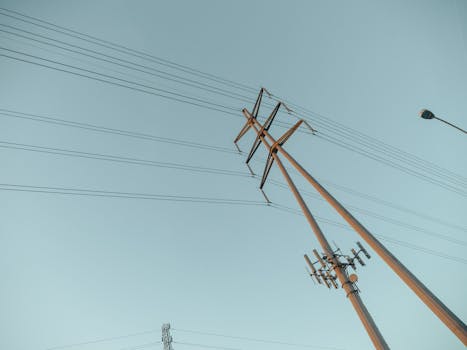“Empower Your Home: Mastering Solar Battery Wiring for Reliable Backup Power.”
Wiring solar batteries for backup power is a crucial step in creating a reliable and efficient solar energy system. This process involves connecting batteries to a solar power system to store energy generated from solar panels, ensuring that power is available during outages or low sunlight conditions. Proper wiring not only maximizes energy storage but also enhances the safety and longevity of the battery system. Understanding the different configurations, such as series and parallel connections, as well as the necessary components like charge controllers and inverters, is essential for effective installation. This guide will provide a comprehensive overview of the steps and considerations involved in wiring solar batteries for optimal backup power performance.
Battery Selection for Solar Backup Systems
When considering a solar backup system, the selection of batteries is a critical step that can significantly influence the overall performance and reliability of the system. The right battery not only stores energy generated by solar panels but also ensures that power is available when needed, particularly during outages or periods of low sunlight. To begin with, it is essential to understand the different types of batteries available for solar applications. The most common options include lead-acid batteries, lithium-ion batteries, and newer technologies such as flow batteries. Each type has its own advantages and disadvantages, which can affect your choice based on your specific needs and budget.
Lead-acid batteries, particularly the deep-cycle variants, have been a staple in solar energy systems for many years. They are generally more affordable upfront and have a proven track record. However, they require regular maintenance, including periodic watering and equalization charges, to ensure longevity. Additionally, lead-acid batteries have a lower depth of discharge, meaning they can only be drained to a certain level before their lifespan is compromised. This limitation can be a significant factor for users who require a substantial amount of backup power.
On the other hand, lithium-ion batteries have gained popularity due to their higher energy density, longer lifespan, and lower maintenance requirements. They can be discharged more deeply without damaging the cells, allowing for more usable energy. Although the initial investment is higher, the long-term savings on maintenance and replacement costs can make them a more economical choice over time. Furthermore, lithium-ion batteries are generally lighter and more compact, making them easier to install in various settings.
As you evaluate your options, it is also crucial to consider the capacity and voltage of the batteries. The capacity, measured in amp-hours (Ah), indicates how much energy the battery can store. To determine the appropriate capacity for your needs, you should calculate your daily energy consumption and consider how many days of backup power you desire. For instance, if your household consumes 30 kWh per day and you want three days of backup, you would need a battery bank with a capacity of at least 90 kWh. However, it is wise to factor in inefficiencies and potential energy losses, which may necessitate a larger capacity.
In addition to capacity, the voltage of the battery system is another critical consideration. Most solar systems operate at either 12V, 24V, or 48V. Higher voltage systems can be more efficient, as they reduce the current flowing through the wires, minimizing energy loss due to resistance. Therefore, if you are designing a new system or upgrading an existing one, it may be beneficial to opt for a higher voltage configuration.
Moreover, it is essential to ensure that the batteries you select are compatible with your solar inverter and charge controller. Mismatched components can lead to inefficiencies or even damage to the system. Therefore, consulting with a knowledgeable installer or conducting thorough research can help you make informed decisions.
Ultimately, the selection of batteries for a solar backup system is a multifaceted process that requires careful consideration of various factors, including type, capacity, voltage, and compatibility. By taking the time to evaluate these elements, you can create a reliable and efficient solar backup system that meets your energy needs and provides peace of mind during power outages.
Wiring Configurations for Solar Batteries

When considering how to wire solar batteries for backup power, understanding the various wiring configurations is essential for optimizing performance and ensuring safety. The configuration you choose will depend on your specific energy needs, the type of batteries you are using, and the overall design of your solar power system. The two primary configurations for wiring solar batteries are series and parallel, each offering distinct advantages and considerations.
Wiring batteries in series is a common approach when you need to increase the voltage of your battery bank. In this configuration, the positive terminal of one battery is connected to the negative terminal of the next battery, creating a chain. For instance, if you connect two 12-volt batteries in series, the total voltage output becomes 24 volts. This method is particularly beneficial for systems that require higher voltage to match the inverter specifications or to reduce current draw, which can minimize energy loss in the wiring. However, it is crucial to ensure that all batteries in a series configuration are of the same type, capacity, and age to prevent imbalances that can lead to reduced performance or even damage.
On the other hand, wiring batteries in parallel is advantageous when you need to increase the overall capacity while maintaining the same voltage. In this setup, all positive terminals are connected together, and all negative terminals are connected together. For example, if you connect two 12-volt batteries in parallel, the voltage remains at 12 volts, but the capacity doubles. This configuration is ideal for applications where longer run times are necessary, such as during extended power outages. However, similar to series wiring, it is essential to use batteries of the same type and capacity to ensure balanced charging and discharging.
Transitioning from these basic configurations, it is also important to consider the implications of combining both series and parallel wiring. This hybrid approach allows for greater flexibility in designing a battery bank that meets specific energy requirements. For instance, you can connect multiple sets of batteries in series to achieve a higher voltage and then connect those sets in parallel to increase capacity. This method can be particularly useful in larger solar power systems where both high voltage and high capacity are needed. However, this complexity requires careful planning and a thorough understanding of the system to avoid potential issues such as unequal charging and discharging rates.
Moreover, regardless of the configuration chosen, proper wiring techniques are critical for safety and efficiency. Using appropriately sized cables is essential to handle the current without overheating, and ensuring all connections are secure will prevent voltage drops and potential hazards. Additionally, incorporating fuses or circuit breakers into the system can provide an extra layer of protection against short circuits or overloads.
In conclusion, selecting the right wiring configuration for solar batteries is a fundamental step in setting up an effective backup power system. Whether opting for series, parallel, or a combination of both, understanding the implications of each choice will help you design a system that meets your energy needs while ensuring safety and reliability. As you embark on this journey, remember that careful planning and adherence to best practices will ultimately lead to a successful solar battery installation that can provide dependable power when you need it most.
Safety Precautions When Wiring Solar Batteries
When it comes to wiring solar batteries for backup power, safety should always be the foremost consideration. The process of connecting batteries involves handling electrical components that can pose risks if not approached with caution. Therefore, understanding and implementing safety precautions is essential to ensure a safe and effective installation.
First and foremost, it is crucial to wear appropriate personal protective equipment (PPE). This includes safety goggles to protect your eyes from potential sparks or debris, gloves to shield your hands from electrical shock and corrosive materials, and sturdy footwear to protect your feet. By equipping yourself with the right gear, you significantly reduce the risk of injury during the installation process.
In addition to personal safety gear, it is vital to work in a well-ventilated area. Batteries, particularly lead-acid types, can emit harmful gases such as hydrogen, especially during charging. Ensuring adequate ventilation minimizes the risk of gas accumulation, which could lead to explosions or health hazards. Furthermore, it is advisable to keep a fire extinguisher nearby, specifically one rated for electrical fires, as a precautionary measure against any unforeseen incidents.
Before beginning the wiring process, it is essential to disconnect all power sources. This includes turning off the solar panel system and any connected devices. By ensuring that there is no live current flowing through the system, you significantly reduce the risk of electric shock. Additionally, it is wise to use a multimeter to verify that there is no voltage present before proceeding with any wiring tasks. This simple step can prevent accidents and ensure a safer working environment.
When selecting the appropriate tools for wiring solar batteries, ensure that they are insulated and rated for the voltage you are working with. Using the right tools not only makes the job easier but also enhances safety. For instance, using insulated wrenches and screwdrivers can help prevent accidental short circuits. Moreover, it is important to familiarize yourself with the battery specifications and wiring diagrams provided by the manufacturer. Understanding the correct configuration for your specific battery type will help avoid mistakes that could lead to dangerous situations.
As you begin the wiring process, always follow the correct sequence for connecting the batteries. Typically, this involves connecting the positive terminals first, followed by the negative terminals. This method minimizes the risk of short circuits and ensures that the system is grounded properly. Additionally, it is crucial to use the appropriate gauge of wire for your setup. Using wires that are too thin can lead to overheating and potential fire hazards, while wires that are too thick may be unnecessarily cumbersome.
Once the batteries are wired, double-check all connections to ensure they are secure and free from corrosion. Loose connections can lead to arcing, which poses a significant fire risk. After confirming that everything is in order, it is advisable to conduct a final inspection of the entire system before re-energizing it. This thorough check can help identify any potential issues that may have been overlooked.
In conclusion, wiring solar batteries for backup power requires careful attention to safety precautions. By wearing appropriate PPE, ensuring proper ventilation, disconnecting power sources, using the right tools, and following correct wiring procedures, you can create a safe and efficient solar battery system. Taking these steps not only protects you during the installation process but also contributes to the long-term reliability and safety of your solar energy setup.
Troubleshooting Common Wiring Issues in Solar Systems
When setting up a solar battery system for backup power, it is essential to understand the potential wiring issues that may arise. Proper troubleshooting can save time, money, and frustration, ensuring that your solar energy system operates efficiently. One of the most common problems encountered is poor connections. Loose or corroded connections can lead to significant voltage drops, which may prevent the system from charging or discharging effectively. To address this, regularly inspect all connections, ensuring they are tight and free from corrosion. If corrosion is present, cleaning the terminals with a wire brush or replacing the connectors may be necessary to restore optimal conductivity.
Another frequent issue is incorrect polarity. When wiring solar batteries, it is crucial to connect the positive terminal of the battery to the positive terminal of the solar charge controller and the negative terminal to the negative terminal. Reversing these connections can damage the batteries and other components in the system. To avoid this, always double-check your wiring before powering up the system. Using color-coded wires can also help prevent mistakes, as red typically indicates positive connections while black denotes negative.
Voltage mismatches between batteries can also pose a significant challenge. When connecting multiple batteries in series or parallel, it is vital to ensure that they are of the same type, capacity, and age. Mixing different batteries can lead to imbalances, resulting in reduced performance and a shorter lifespan for the entire system. If you suspect a voltage mismatch, use a multimeter to measure the voltage of each battery. If discrepancies are found, consider replacing the weaker batteries to maintain system integrity.
In addition to these issues, overheating can occur due to inadequate wire gauge. If the wires used in your solar battery system are too thin for the current they carry, they can overheat, leading to potential failure or even fire hazards. To prevent this, refer to the American Wire Gauge (AWG) standards to select the appropriate wire size based on the current and distance of the run. Ensuring that your wiring is adequately rated for the load will enhance safety and efficiency.
Furthermore, it is essential to be aware of the potential for ground faults. A ground fault occurs when a live wire comes into contact with a grounded surface, which can lead to short circuits and equipment damage. To mitigate this risk, ensure that all components are properly grounded and that the wiring is insulated and protected from physical damage. Regularly inspecting the system for signs of wear or damage can help identify potential ground faults before they become serious issues.
Lastly, monitoring the performance of your solar battery system is crucial for early detection of wiring issues. Many modern systems come equipped with monitoring tools that provide real-time data on voltage, current, and overall system performance. By keeping an eye on these metrics, you can quickly identify any irregularities that may indicate wiring problems. If you notice significant drops in performance or unexpected fluctuations, it may be time to conduct a thorough inspection of your wiring and connections.
In conclusion, troubleshooting common wiring issues in solar systems requires vigilance and a proactive approach. By regularly inspecting connections, ensuring correct polarity, matching battery voltages, using appropriate wire gauges, preventing ground faults, and monitoring system performance, you can maintain a reliable and efficient solar battery system for backup power. Taking these steps will not only enhance the longevity of your system but also ensure that you have a dependable source of energy when you need it most.
Q&A
1. **Question:** What type of batteries are commonly used for solar backup power?
**Answer:** Deep cycle lead-acid batteries (such as AGM or gel) and lithium-ion batteries are commonly used for solar backup power.
2. **Question:** How do you connect multiple batteries in a solar backup system?
**Answer:** Batteries can be connected in series to increase voltage or in parallel to increase capacity; ensure all batteries are of the same type and capacity.
3. **Question:** What safety precautions should be taken when wiring solar batteries?
**Answer:** Always wear protective gear, ensure the system is powered off before working, use appropriate gauge wiring, and follow manufacturer guidelines.
4. **Question:** What is the role of a charge controller in a solar battery system?
**Answer:** A charge controller regulates the voltage and current coming from the solar panels to the batteries, preventing overcharging and ensuring optimal battery health.
Conclusion
To wire solar batteries for backup power, first, ensure you have the appropriate batteries, charge controller, inverter, and wiring. Connect the batteries in parallel or series depending on your voltage requirements, ensuring proper polarity. Use a charge controller to regulate the charging from the solar panels and connect the inverter to convert DC to AC power for household use. Finally, ensure all connections are secure and follow safety protocols. In conclusion, proper wiring and configuration of solar batteries can effectively provide reliable backup power, enhancing energy independence and resilience during outages.




